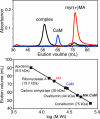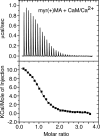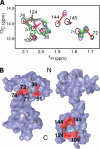Binding of calmodulin to the HIV-1 matrix protein triggers myristate exposure
- PMID: 20956522
- PMCID: PMC3009918
- DOI: 10.1074/jbc.M110.179093
Binding of calmodulin to the HIV-1 matrix protein triggers myristate exposure
Abstract
Steady progress has been made in defining both the viral and cellular determinants of retroviral assembly and release. Although it is widely accepted that targeting of the Gag polypeptide to the plasma membrane is critical for proper assembly of HIV-1, the intracellular interactions and trafficking of Gag to its assembly sites in the infected cell are poorly understood. HIV-1 Gag was shown to interact and co-localize with calmodulin (CaM), a ubiquitous and highly conserved Ca(2+)-binding protein expressed in all eukaryotic cells, and is implicated in a variety of cellular functions. Binding of HIV-1 Gag to CaM is dependent on calcium and is mediated by the N-terminally myristoylated matrix (myr(+)MA) domain. Herein, we demonstrate that CaM binds to myr(+)MA with a dissociation constant (K(d)) of ∼2 μm and 1:1 stoichiometry. Strikingly, our data revealed that CaM binding to MA induces the extrusion of the myr group. However, in contrast to all known examples of CaM-binding myristoylated proteins, our data show that the myr group is exposed to solvent and not involved in CaM binding. The interactions between CaM and myr(+)MA are endothermic and entropically driven, suggesting that hydrophobic contacts are critical for binding. As revealed by NMR data, both CaM and MA appear to engage substantial regions and/or undergo significant conformational changes upon binding. We believe that our findings will provide new insights on how Gag may interact with CaM during the HIV replication cycle.
Figures







Similar articles
-
Solution structure of calmodulin bound to the binding domain of the HIV-1 matrix protein.J Biol Chem. 2014 Mar 21;289(12):8697-705. doi: 10.1074/jbc.M113.543694. Epub 2014 Feb 5. J Biol Chem. 2014. PMID: 24500712 Free PMC article.
-
NMR, biophysical, and biochemical studies reveal the minimal Calmodulin binding domain of the HIV-1 matrix protein.J Biol Chem. 2011 Sep 23;286(38):33533-43. doi: 10.1074/jbc.M111.273623. Epub 2011 Jul 28. J Biol Chem. 2011. PMID: 21799007 Free PMC article.
-
Calmodulin disrupts the structure of the HIV-1 MA protein.J Mol Biol. 2010 Jul 23;400(4):702-14. doi: 10.1016/j.jmb.2010.05.022. Epub 2010 May 19. J Mol Biol. 2010. PMID: 20488189 Free PMC article.
-
Structure, dynamics and interaction with kinase targets: computer simulations of calmodulin.Biochim Biophys Acta. 2004 Mar 11;1697(1-2):289-300. doi: 10.1016/j.bbapap.2003.11.032. Biochim Biophys Acta. 2004. PMID: 15023369 Review.
-
A Non-Canonical Calmodulin Target Motif Comprising a Polybasic Region and Lipidated Terminal Residue Regulates Localization.Int J Mol Sci. 2020 Apr 15;21(8):2751. doi: 10.3390/ijms21082751. Int J Mol Sci. 2020. PMID: 32326637 Free PMC article. Review.
Cited by
-
The frantic play of the concealed HIV envelope cytoplasmic tail.Retrovirology. 2013 May 24;10:54. doi: 10.1186/1742-4690-10-54. Retrovirology. 2013. PMID: 23705972 Free PMC article. Review.
-
Solution structure of calmodulin bound to the binding domain of the HIV-1 matrix protein.J Biol Chem. 2014 Mar 21;289(12):8697-705. doi: 10.1074/jbc.M113.543694. Epub 2014 Feb 5. J Biol Chem. 2014. PMID: 24500712 Free PMC article.
-
KRAS Prenylation Is Required for Bivalent Binding with Calmodulin in a Nucleotide-Independent Manner.Biophys J. 2019 Mar 19;116(6):1049-1063. doi: 10.1016/j.bpj.2019.02.004. Epub 2019 Feb 15. Biophys J. 2019. PMID: 30846362 Free PMC article.
-
Role of the HIV-1 Matrix Protein in Gag Intracellular Trafficking and Targeting to the Plasma Membrane for Virus Assembly.Front Microbiol. 2012 Feb 17;3:55. doi: 10.3389/fmicb.2012.00055. eCollection 2012. Front Microbiol. 2012. PMID: 22363329 Free PMC article.
-
Self-assembly of filamentous amelogenin requires calcium and phosphate: from dimers via nanoribbons to fibrils.Biomacromolecules. 2012 Nov 12;13(11):3494-502. doi: 10.1021/bm300942c. Epub 2012 Sep 28. Biomacromolecules. 2012. PMID: 22974364 Free PMC article.
References
-
- Adamson C. S., Freed E. O. (2007) Adv. Pharmacol. 55, 347–387 - PubMed
Publication types
MeSH terms
Substances
Grants and funding
LinkOut - more resources
Full Text Sources
Research Materials
Miscellaneous

